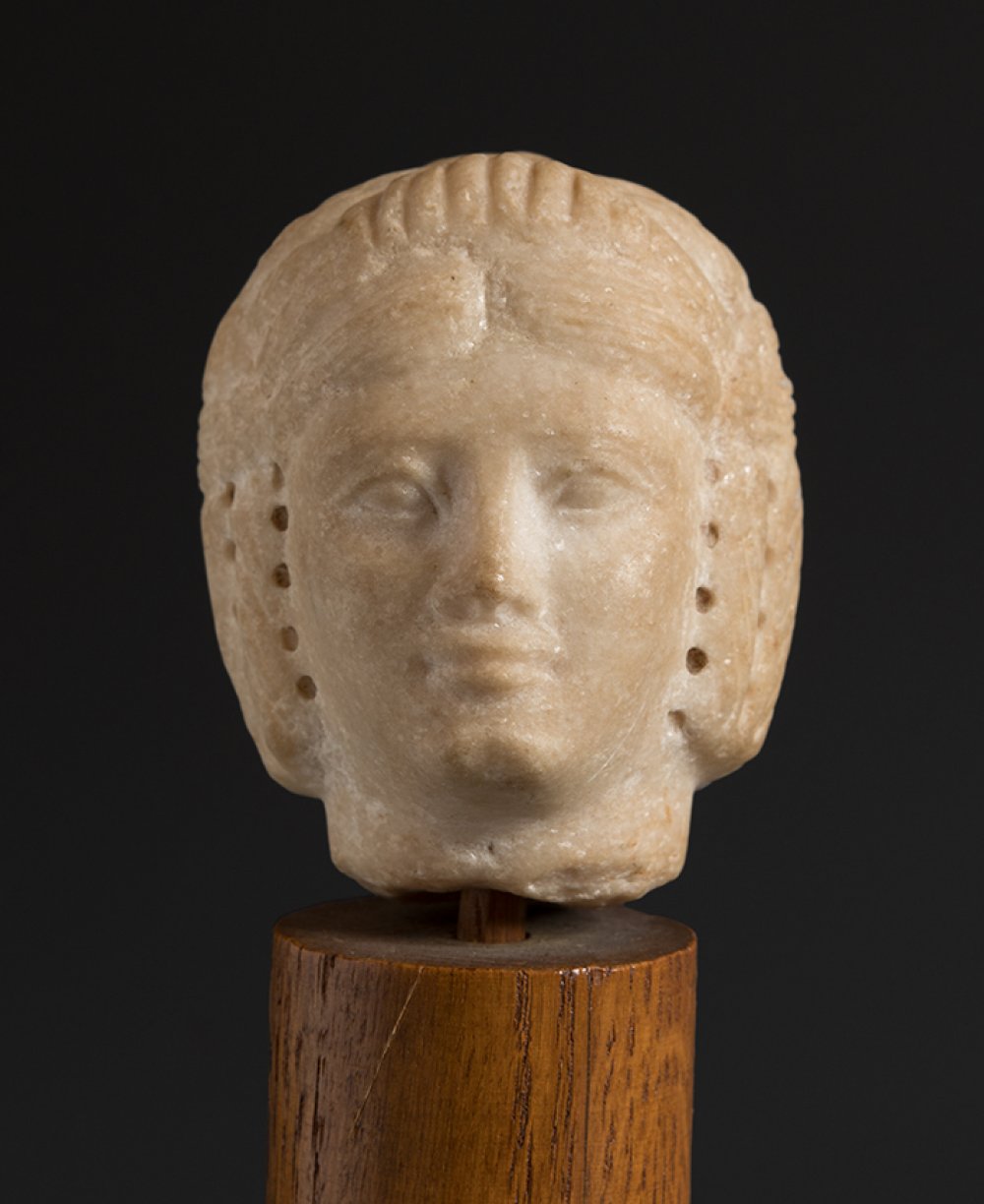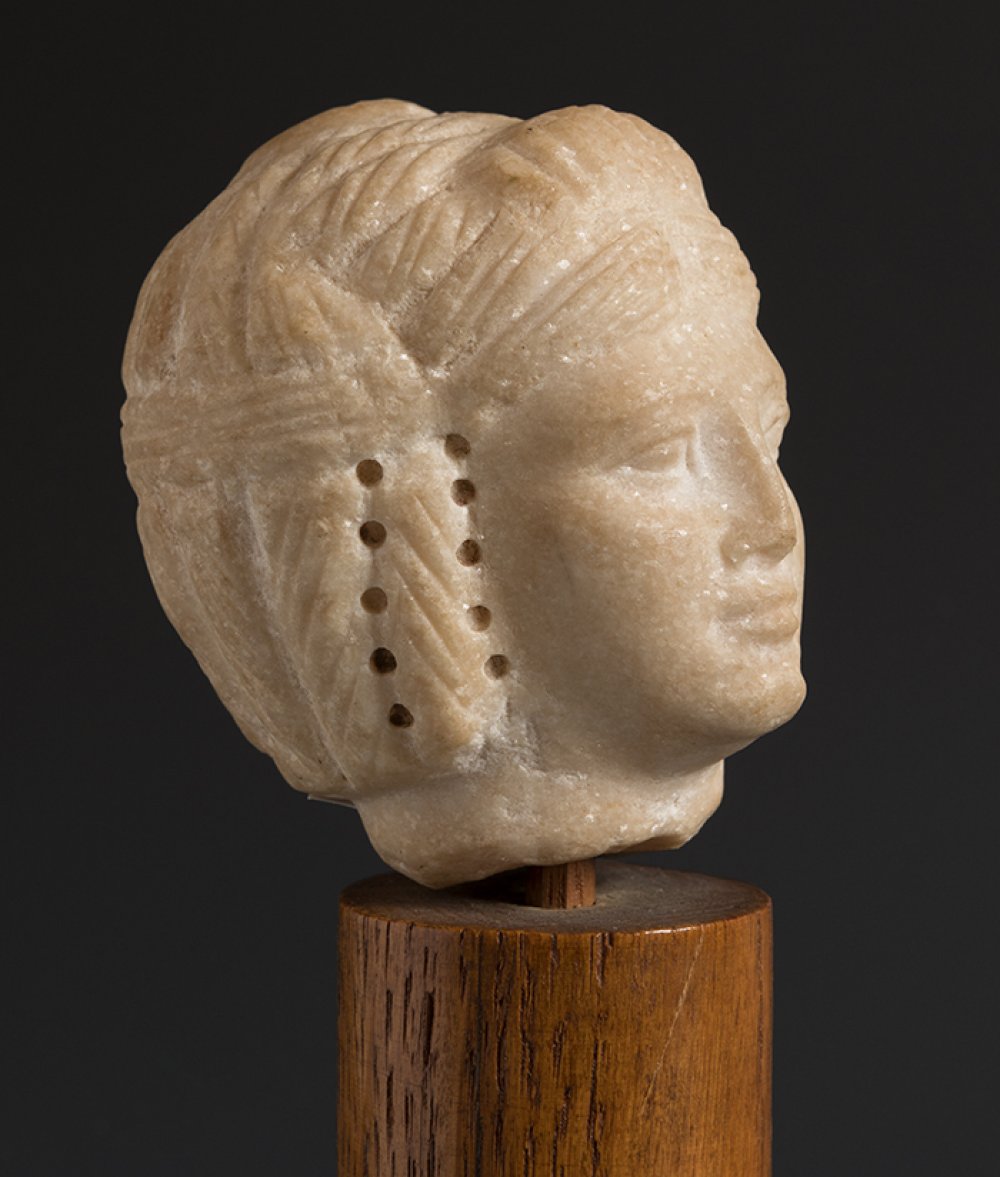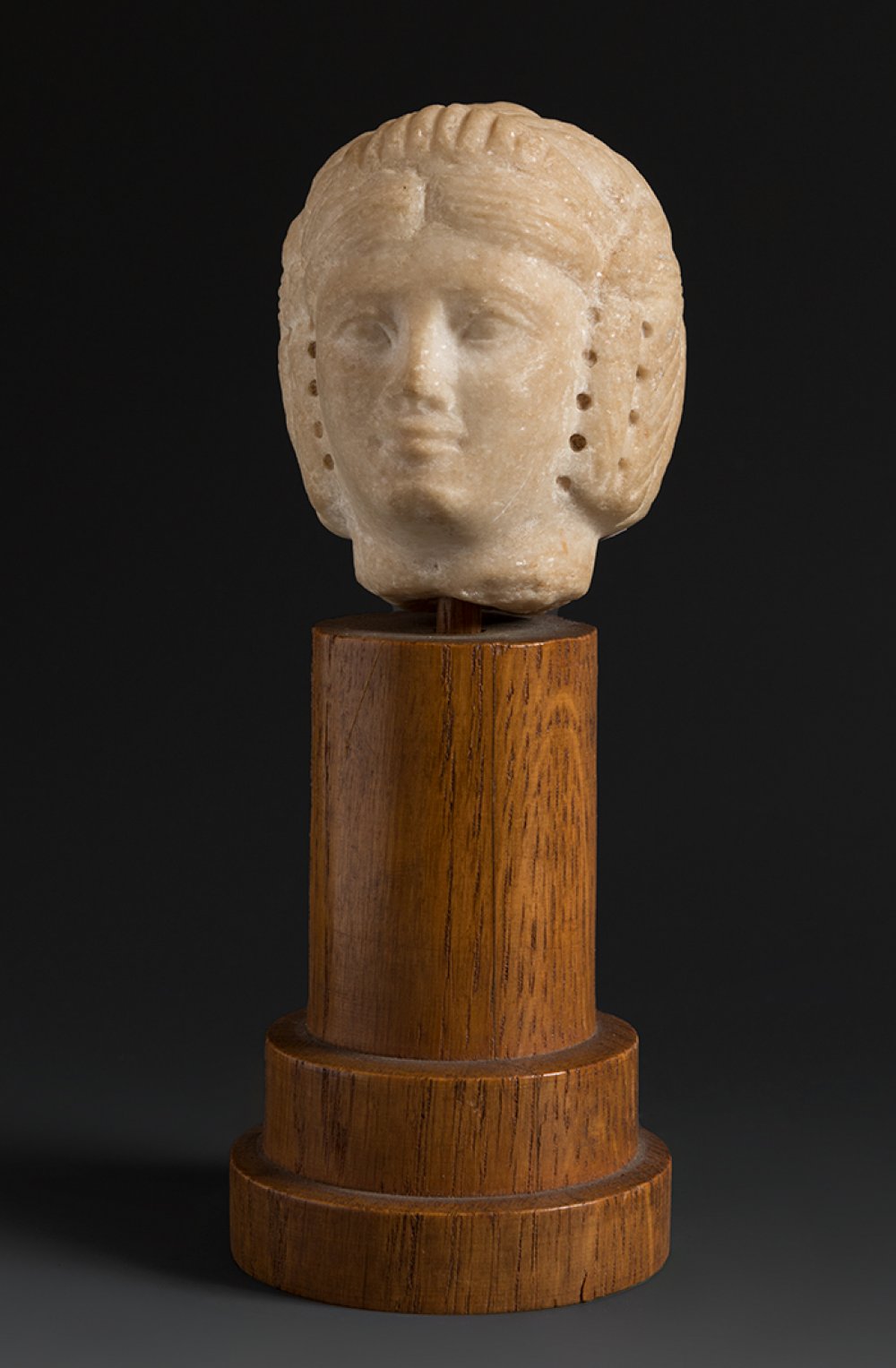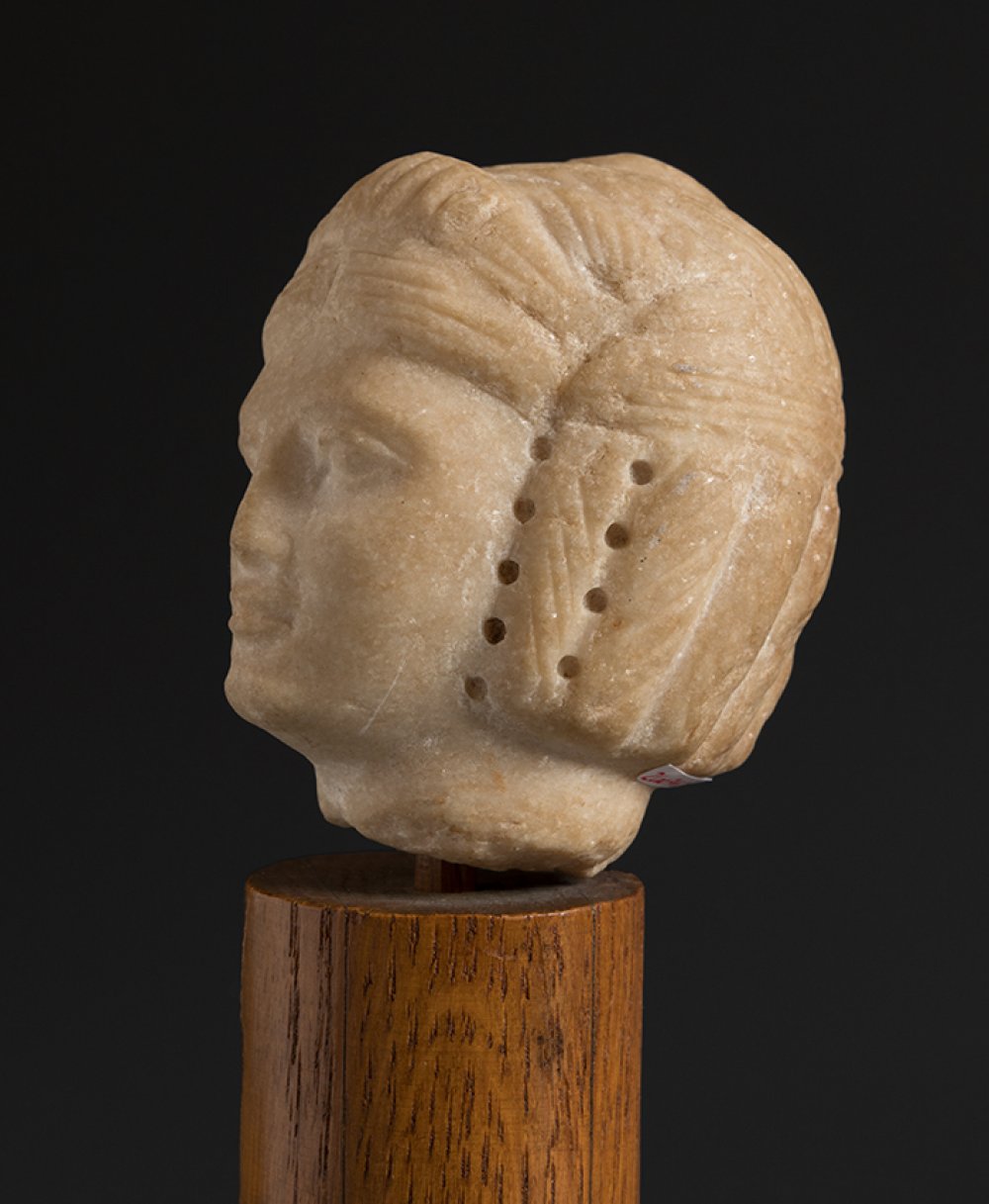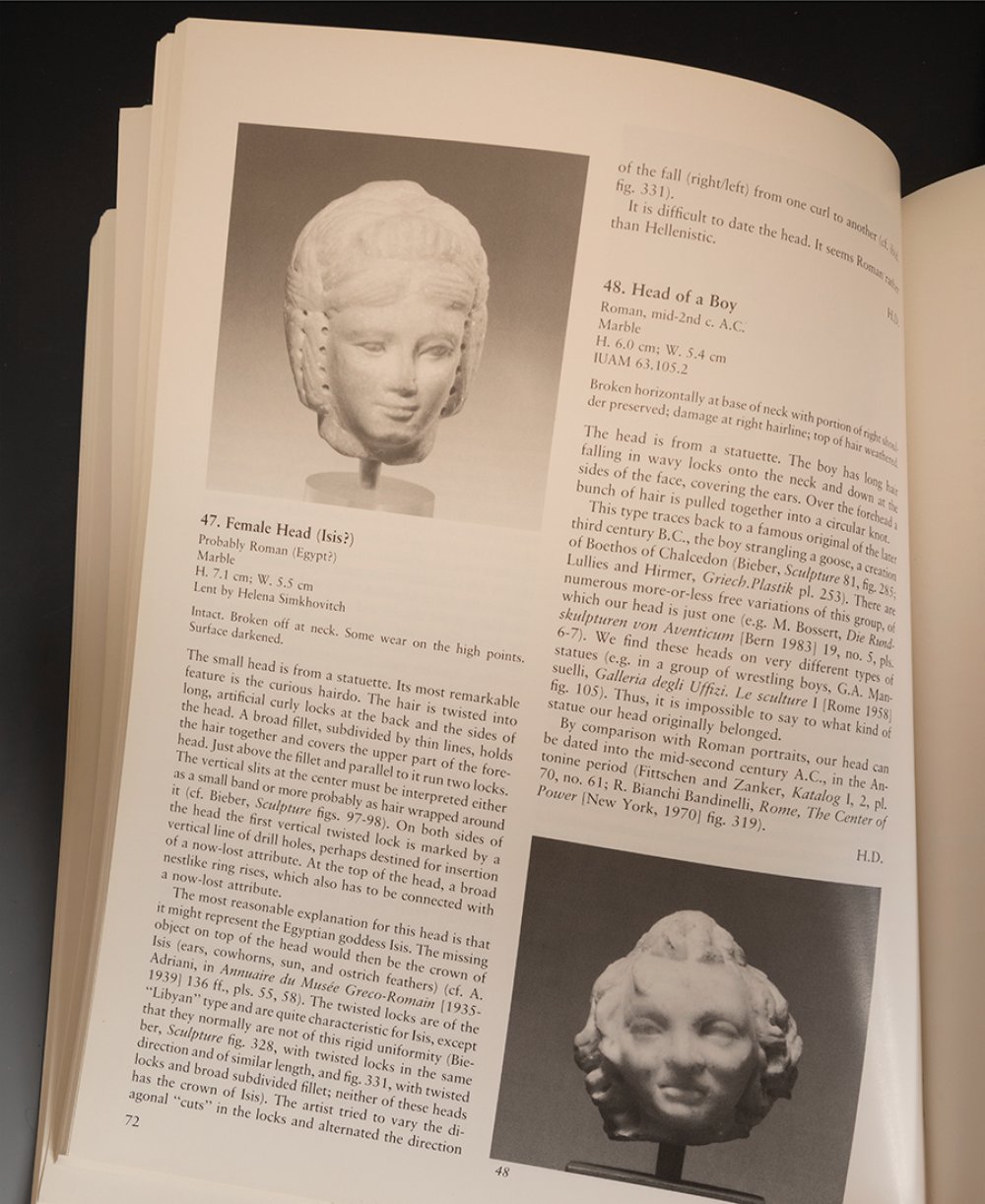13
Female head. Rome, 2nd century BC-2nd century AD.Marble.Provenance: Private collection of Vladimir
Marble.
Provenance: Private collection of Vladimir Gregorievitch Simkhovitch, professor of economics at Columbia University (1874-1959), USA. Vladimir was a great collector of ancient art and works from his collection are held in the Smithsonian Musuem, the Metropolitan Museum, NY or the Brooklyn Museum among others.
Publications: Ancient art from the V.G. Simkhovitch collection, Wolf Rudolph and Adriana Calinescu, Indiana University Art Museum. 1998. Page 72.
In good condition.
Measurements: 7 cm (height).
Female head belonging to a small sculpture. It shows idealised feminine features, although with a certain naturalism already, with short hair and open eyes, fixed straight ahead. The publication "Ancient art from the V.G. Simkhovitch collection" suggests that it could be a representation of Isis, although she does not retain her crown. The elaborate workmanship of her hair, delicately gathered in a hairnet that structures it into compartments, is noteworthy.
The Romans brought two important innovations to the world of sculpture: portraiture and historical relief, neither of which existed in the Greek world. However, they followed Greek models for much of their sculptural production, a base which in Rome was combined with the Etruscan tradition. After the first contacts with Classical Greece through the Magna Graecia colonies, the Romans conquered Syracuse in 212 BC, a rich and important Greek colony in Sicily, which was adorned with a large number of Hellenistic works. The city was sacked and its artistic treasures taken to Rome, where the new style of these works soon replaced the Etruscan-Roman tradition that had prevailed until then. Shortly afterwards, in 133 BC, the Empire inherited the kingdom of Pergamon, where there was an original and thriving school of Hellenistic sculpture. The huge Pergamon Altar, the "Gallus committing suicide" or the dramatic group "Laocoön and his sons" were three of the key creations of this Hellenistic school. On the other hand, after Greece was conquered in 146 BC, most Greek artists settled in Rome, and many of them devoted themselves to making copies of Greek sculptures, which were very fashionable at the time in the capital of the Empire. Thus, numerous copies of Praxiteles, Lysippus and classical works of the 5th century BC were produced, giving rise to the Neo-Attic school of Rome, the first neoclassical movement in the history of art. However, between the end of the 2nd century BC and the beginning of the 1st century BC there was a change in this purist Greek trend, which culminated in the creation of a national school of sculpture in Rome, which produced works such as the Altar of Aenobarbus, which introduced a typically Roman narrative concept that became a chronicle of everyday life and, at the same time, of the success of its political model. This school would be the forerunner of the great imperial art of Augustus, under whose rule Rome became the most influential city in the Empire and also the new centre of Hellenistic culture, as Pergamon and Alexandria had been before it, attracting a large number of Greek artists and craftsmen. In the Augustan era Rome contributed to the continuity and renewal of a tradition which had already enjoyed centuries of prestige and which had dictated the character of all art in the area. In this new phase, Greek aesthetics and technique were applied to the themes of this new Rome. After the idealisation of the Augustan period, the realism of the Flavian era and the subsequent Baroque style of the 2nd and 3rd centuries, Roman sculpture, marked by the presence of Christianity, tended to dehumanise, becoming more ideal and symbolic. The concern for realism was lost, and there was a tendency towards a schematisation that sought to capture the ideal, the soul or the divinity, rather than the human aspect of the figures. The carving, in keeping with this new aesthetic, acquired a great hardness, and the figures acquired a noble hieratism.
Marble.
Provenance: Private collection of Vladimir Gregorievitch Simkhovitch, professor of economics at Columbia University (1874-1959), USA. Vladimir was a great collector of ancient art and works from his collection are held in the Smithsonian Musuem, the Metropolitan Museum, NY or the Brooklyn Museum among others.
Publications: Ancient art from the V.G. Simkhovitch collection, Wolf Rudolph and Adriana Calinescu, Indiana University Art Museum. 1998. Page 72.
In good condition.
Measurements: 7 cm (height).
Female head belonging to a small sculpture. It shows idealised feminine features, although with a certain naturalism already, with short hair and open eyes, fixed straight ahead. The publication "Ancient art from the V.G. Simkhovitch collection" suggests that it could be a representation of Isis, although she does not retain her crown. The elaborate workmanship of her hair, delicately gathered in a hairnet that structures it into compartments, is noteworthy.
The Romans brought two important innovations to the world of sculpture: portraiture and historical relief, neither of which existed in the Greek world. However, they followed Greek models for much of their sculptural production, a base which in Rome was combined with the Etruscan tradition. After the first contacts with Classical Greece through the Magna Graecia colonies, the Romans conquered Syracuse in 212 BC, a rich and important Greek colony in Sicily, which was adorned with a large number of Hellenistic works. The city was sacked and its artistic treasures taken to Rome, where the new style of these works soon replaced the Etruscan-Roman tradition that had prevailed until then. Shortly afterwards, in 133 BC, the Empire inherited the kingdom of Pergamon, where there was an original and thriving school of Hellenistic sculpture. The huge Pergamon Altar, the "Gallus committing suicide" or the dramatic group "Laocoön and his sons" were three of the key creations of this Hellenistic school. On the other hand, after Greece was conquered in 146 BC, most Greek artists settled in Rome, and many of them devoted themselves to making copies of Greek sculptures, which were very fashionable at the time in the capital of the Empire. Thus, numerous copies of Praxiteles, Lysippus and classical works of the 5th century BC were produced, giving rise to the Neo-Attic school of Rome, the first neoclassical movement in the history of art. However, between the end of the 2nd century BC and the beginning of the 1st century BC there was a change in this purist Greek trend, which culminated in the creation of a national school of sculpture in Rome, which produced works such as the Altar of Aenobarbus, which introduced a typically Roman narrative concept that became a chronicle of everyday life and, at the same time, of the success of its political model. This school would be the forerunner of the great imperial art of Augustus, under whose rule Rome became the most influential city in the Empire and also the new centre of Hellenistic culture, as Pergamon and Alexandria had been before it, attracting a large number of Greek artists and craftsmen. In the Augustan era Rome contributed to the continuity and renewal of a tradition which had already enjoyed centuries of prestige and which had dictated the character of all art in the area. In this new phase, Greek aesthetics and technique were applied to the themes of this new Rome. After the idealisation of the Augustan period, the realism of the Flavian era and the subsequent Baroque style of the 2nd and 3rd centuries, Roman sculpture, marked by the presence of Christianity, tended to dehumanise, becoming more ideal and symbolic. The concern for realism was lost, and there was a tendency towards a schematisation that sought to capture the ideal, the soul or the divinity, rather than the human aspect of the figures. The carving, in keeping with this new aesthetic, acquired a great hardness, and the figures acquired a noble hieratism.
29th September - Archaeology
Sale Date(s)
Venue Address
General delivery information available from the auctioneer
Setdart offers Worldwide shipping
PICK UP IN ROOM: You can come and pick up your lots in our offices (Barcelona, Madrid or Valencia). At the moment of the withdrawal, you will be able to accept the current conditions of the lot by means of a document that you will sign.
YOU CAN SEND ANOTHER PERSON TO PICK UP: This person must present a signed authorization that you can find in our web page by accessing from BUY AT SETDART- LOGISTICS-DOWNLOAD AUTHORIZATION DOCUMENT. You can also send an e-mail with the requested data in AUTHORIZATION DOCUMENT to admin@setdart.com
Important Information
25% buyer´s premium
21% buyer´s premium at www.setdart.com
Terms & Conditions
The maximum period to pay the lots is 7 working days. You can pay either via bank transfer or with credit card through our platform www.setdart.com (we only accept VISA or Mastercard).
BUYER´S PREMIUM: 22% Hammer price + 21% VAT from the buyer´s premium
If your piece has more than 100 years, our Ministry of Culture requires an export certificate in order for the piece to leave the country. Note that if the piece goes inside the EU, there is no cost for the export certificate. If the piece goes outside the EU, there is a cost for the export certificate. You can find more information in our Ministry of Culture website: https://www.culturaydeporte.gob.es/en/cultura/patrimonio/exportacionimportacion/exportacion/tasas.html
INQUIRIES: admin@setdart.com
Setdart guides you through the entire process, from the time of award to the day you receive your lot. Our logistics team will be happy to manage your transport, and will advise you on the best shipping method with professionals from the sector used to handling works of art and jewelry.
WE OFFER WORLDWIDE DOOR TO DOOR SHIPPING
PICK UP IN ROOM: You can come and pick up your lots in our offices. At the moment of the withdrawal, you will be able to accept the current conditions of the lot by means of a document that you will sign.
YOU CAN SEND ANOTHER PERSON TO PICK UP: This person must present a signed authorization that you can find in our web page by accessing from BUY AT SETDART-LOGISTICS-DOWNLOAD AUTHORIZATION DOCUMENT. You can also send an e-mail with the requested data in AUTHORIZATION DOCUMENT to admin@setdart.com
SETDART IS NOT RESPONSIBLE FOR THE STATE OF THE PARTS ONCE THEY LEAVE OUR FACILITIES. MRW SHIPMENTS: Once the payment is made, your lot will be packed for shipment, the logistics department will send you an e-mail notifying you of the day it leaves our warehouse, changes of address cannot be made after receiving this e-mail.
INSURANCE INCIDENTS: Coverage for the value of the auction up to 3000 ? per shipment, if the value of the auction is higher, Setdart will send you a quote including the additional insurance. The insurance company WILL NOT BE RESPONSIBLE FOR THE SHIPMENT THAT EXCEEDS THAT AMOUNT AND IS NOT FULLY INSURED. MRW INCIDENTS: Maximum notification 48 hours after receipt, after which the insurance company WILL NOT BE RESPONSIBLE AND NO CLAIMS WILL BE ACCEPTED.
E-MAIL LOGISTICS: logistica@setdart.com
PICK UP YOUR MESSAGES: You can send your own messaging, prior notice via e-mail that your shipment is ready, please note 3 or 4 days in advance. This type of shipment is packaged so Setdart will provide you with a quote.
EXPENSES FOR STORAGE: We inform you that if the purchased lot is not picked up within a month, you will be charged 30€ per week per lot. Setdart Online S.L., owner of the web site "setdart.com", "setdart.net" and "setdart.org", acts as a company of Spanish nationality inscribed in the Volume 36955, sheet 182, page B-293056 of the Mercantile Registry, with registered office at Calle Aragó















